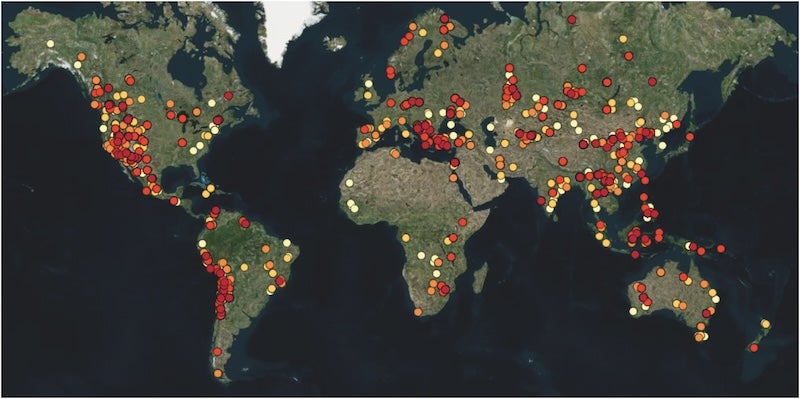
Repurposing an existing mining pit, lake, tailings pond, or underground mining tunnel as a pumped storage reservoir can often overcome some of the problems presented when trying to develop other greenfield alternatives. As Weber et al discuss in their recent research published in Renewable Energy, many potential closed-loop greenfield pumped storage sites are located far from existing transmission, access roads, and water pumping infrastructure. Such sites also need to obtain a social licence for the entire development area.
In comparison, if using an existing mining pit, lake, or tailings dam as one of the reservoirs, these licences and infrastructure would typically have been required for mining operations. Mining sites are also often located close to existing transmission because electricity is required for mining operations, generally require road and water access, and can thus provide existing infrastructure or permits that facilitate the construction and operation of a pumped hydro storage system, the initial reservoir fill, and reservoir top-ups to replace evaporation losses and seepage. Since land was previously cleared for the operation of the mine, the need to clear additional vegetation for at least one reservoir can also be minimised or even eliminated.
Weber et al go on to explain that previous use as a mining site reduces the chance that pumped storage development there will impact land which retains cultural, social, environmental or religious significance. However, they caution, it should be noted that many brownfield sites will require a new reservoir at a different altitude that might be located outside the mining area, and so subject to restrictions imposed by any competing interests.
Furthermore, the authors claim that one (or even both) of the reservoir pairs in a brownfield site could be prepared at very low cost, as mining sites can be shaped during the end stages of mining to form a pumped hydro reservoir. In some cases, the cost of this would be similar to the cost of business-as-usual operations.
New atlas identifies pumped storage potential
Prior to their research, Weber et al say there wasn’t a global database of potential pumped storage sites that repurpose mining pits, pit lakes, or tailings ponds available. Although a previous study had identified 616,000 potential greenfield closed loop pumped hydro sites around the world, with combined storage of 23,000TWh.
In their study, Weber et al have identified 904 sites in mining areas (brownfield) with a combined potential storage of 30TWh. These are available online in a high spatial resolution global atlas, developed through Geographic Information System analysis of a digital terrain model. All sites were assigned a cost class to allow comparison between sites on the global atlas.
There are much fewer eligible locations for brownfield options, with 77 countries found to contain eligible locations. Despite this though, the authors say these sites typically have other advantages including existing transmission infrastructure (in Australia, 84% of these brownfield sites were within 10km of existing transmission lines), water pumping infrastructure, road access, social licence and reduced environmental impact for development on disturbed land.
The authors also reiterate there are other considerations if constructing pumped hydro systems on old mining sites. For example, reservoir linings may be required to prevent seepage, treat soil and water released from the reservoir. Unstable slopes, tunnels, powerhouse caverns or tailings dams may also need reinforcement to handle rapid changes in water level. These design considerations are site-specific, the authors explain, and would be relevant if any pumped hydro site in the Brownfield Atlas was investigated in detail.
Rehabilitating disused mining sites is a growing global problem that will require multiple solutions to address it. Weber et al report that there are over 80,000 inactive mining sites requiring rehabilitation within Australia alone – 37 of which were suitable for pumped storage systems larger than 2GWh.
Various mining sites are already being developed or investigated for their potential as pumped storage systems. These include Kidston Pumped Storage Hydro Project in Queensland, Australia (250MW, 2000MWh) which will connect two mining pits together and is expected to be completed in 2025.
Other proposed projects in Australia include the Mt Rawdon Pumped Hydro Project (2GW, 20GWh), which would repurpose a mining pit, and the Muswellbrook Pumped Hydro project (250MW, 2000 Wh), which would use existing coal mine voids as the lower reservoir.
In the US, the disturbed land of the Kaiser Eagle Mountain mine (1.3GW, 24GWh) and Lewis Ridge mine (200MW, 1600MWh) are being considered for closed-loop projects. By the end of 2022, a total of 13 projects with 3.42GW power capacity located on mining land were estimated to be in the development pipeline across the US.

Batman Dam
Other research has investigated a model for integrating a pumped storage system into an existing dam structure. In their study, Oymak et al used Turkey’s Batman Dam and Hydroelectric Power Plant as the lower reservoir. Situated within the Euphrates-Tigris basin, and under the operation of The Electricity Generation Corporation, this power plant ranks as the 88th largest in Turkey, boasting an installed capacity of 198.48MW and yielding a total electrical energy output of 483 GWh.
As the authors claim in The Journal of Energy Storage: “Turkey’s abundant hydroelectric potential highlights the promising approach of converting existing reservoirs into pumped storage systems, demonstrating a hopeful strategy for efficient energy utilisation and energy continuity.”
In this research, a suitability map for the location of the second reservoir was generated using multi-criteria decision-making analysis, with the assistance of GIS for pumped storage conversion. A mathematical model encompassing various components of the PHS system was also presented to calculate the energy potential of the dam.
The authors say that their calculations indicate 1299 kWh of energy storage can be provided within the scope of the study, when using Batman Hydroelectric Power Plant as the lower reservoir. These findings, they add, “demonstrate that a more practical model, accounting for energy losses yields more accurate results”.






